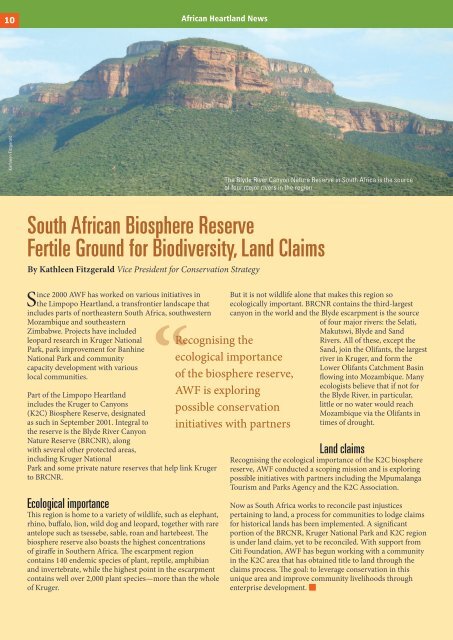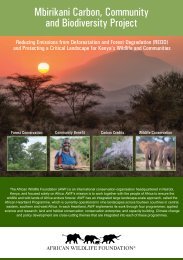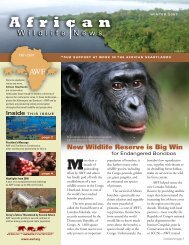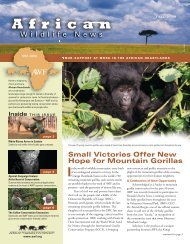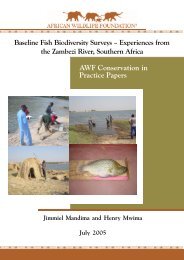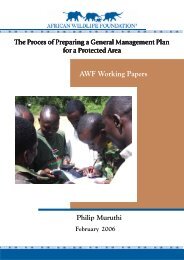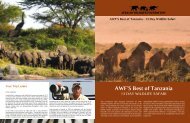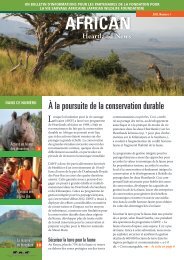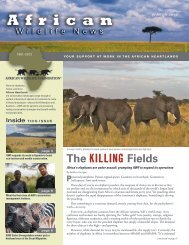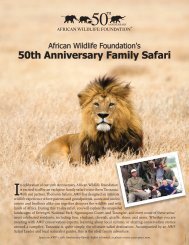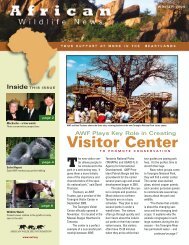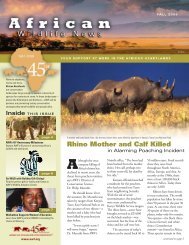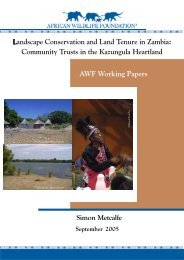Download (English) - African Wildlife Foundation
Download (English) - African Wildlife Foundation
Download (English) - African Wildlife Foundation
Create successful ePaper yourself
Turn your PDF publications into a flip-book with our unique Google optimized e-Paper software.
10<br />
2 <strong>African</strong> Heartland News<br />
<strong>African</strong> Heartland News<br />
Kathleen Fitzgerald<br />
The Blyde River Canyon Nature Reserve in South Africa is the source<br />
of four major rivers in the region.<br />
South <strong>African</strong> Biosphere Reserve<br />
Fertile Ground for Biodiversity, Land Claims<br />
By Kathleen Fitzgerald Vice President for Conservation Strategy<br />
Since 2000 AWF has worked on various initiatives in<br />
the Limpopo Heartland, a transfrontier landscape that<br />
includes parts of northeastern South Africa, southwestern<br />
Mozambique and southeastern<br />
Zimbabwe. Projects have included<br />
leopard research in Kruger National<br />
Park, park improvement for Banhine<br />
National Park and community<br />
capacity development with various<br />
local communities.<br />
Part of the Limpopo Heartland<br />
includes the Kruger to Canyons<br />
(K2C) Biosphere Reserve, designated<br />
as such in September 2001. Integral to<br />
the reserve is the Blyde River Canyon<br />
Nature Reserve (BRCNR), along<br />
with several other protected areas,<br />
including Kruger National<br />
Park and some private nature reserves that help link Kruger<br />
to BRCNR.<br />
Ecological importance<br />
This region is home to a variety of wildlife, such as elephant,<br />
rhino, buffalo, lion, wild dog and leopard, together with rare<br />
antelope such as tsessebe, sable, roan and hartebeest. The<br />
biosphere reserve also boasts the highest concentrations<br />
of giraffe in Southern Africa. The escarpment region<br />
contains 140 endemic species of plant, reptile, amphibian<br />
and invertebrate, while the highest point in the escarpment<br />
contains well over 2,000 plant species—more than the whole<br />
of Kruger.<br />
But it is not wildlife alone that makes this region so<br />
ecologically important. BRCNR contains the third-largest<br />
canyon in the world and the Blyde escarpment is the source<br />
of four major rivers: the Selati,<br />
Recognising the<br />
ecological importance<br />
of the biosphere reserve,<br />
AWF is exploring<br />
possible conservation<br />
initiatives with partners<br />
Makutswi, Blyde and Sand<br />
Rivers. All of these, except the<br />
Sand, join the Olifants, the largest<br />
river in Kruger, and form the<br />
Lower Olifants Catchment Basin<br />
flowing into Mozambique. Many<br />
ecologists believe that if not for<br />
the Blyde River, in particular,<br />
little or no water would reach<br />
Mozambique via the Olifants in<br />
times of drought.<br />
Land claims<br />
Recognising the ecological importance of the K2C biosphere<br />
reserve, AWF conducted a scoping mission and is exploring<br />
possible initiatives with partners including the Mpumalanga<br />
Tourism and Parks Agency and the K2C Association.<br />
Now as South Africa works to reconcile past injustices<br />
pertaining to land, a process for communities to lodge claims<br />
for historical lands has been implemented. A significant<br />
portion of the BRCNR, Kruger National Park and K2C region<br />
is under land claim, yet to be reconciled. With support from<br />
Citi <strong>Foundation</strong>, AWF has begun working with a community<br />
in the K2C area that has obtained title to land through the<br />
claims process. The goal: to leverage conservation in this<br />
unique area and improve community livelihoods through<br />
enterprise development. m


